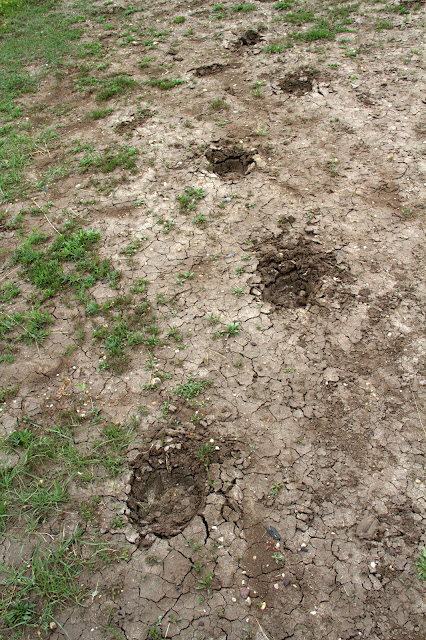Click on the scenic photos.
On our way out of Wall, we stopped at Wall Drugs, which was already teaming with tourists, like us.
Did you know: if you look up tourist trap on Wikipedia, the first photo is a picture of a Wall Drug billboard? The 3rd generation owner Ted Husted prefers the expression "roadside attraction" as he points out that admission and parking are free. He has a point.
 |
| There's even a multi-denominational chapel for the weary traveler. Or the fresh traveler. |
 |
| Museum quality collectibles from the early days when Wall Drug was simply a drugstore. |
We walked through the indoor mall that is Wall Drug, looking at the souvenirs, admiring their donuts and, finally, moved on. But, I'll tell you what...it was actually pretty interesting, especially the collection of Americana...like a folk/western museum. I'd go back for that. And a donut.
Anyway, off to the Badlands, which were just a few minutes from Wall.
So, it turns out that the expression "badlands" is generic, referring to a type of dry terrain where wind and water have eroded softer sedimentary rock and clay-rich soil. Want to know what makes them so damned bad? Read on.
 |
| There's some special about seeing wild animals in...ummm...the wild? Yeah...the wild, in their native habitat...like this bighorn sheep ewe. It's just cool. You have to come here. |
 |
| The main road through the park has a couple of side roads. We took off on a 20 mile detour featuring one amazing view of the park after another. The 64000+ acres in the distance is U.S. Wilderness Area;no vehicles, no roads, camping and hunting by permit. BTW, this panorama is 25' wide. Do you need one? Or two? Sadly, with the sun obscured by clouds, the colors are muted. Silent. I can neither see nor hear them. The colors, that is. |
 |
| Wild sheep crossed the Bering land bridge from Siberia during the Pleistocene era, about 750,000 years ago, spreading through western North America. The males have the big round horns. |
 |
| I think we were speaking each other's unspoken language. At least until she ran away. |
 |
| Extensive poisoning programs virtually eradicated the prairie dog and many of its predators, chief among them the black-footed ferret. Formerly the prairie dog's most dangerous enemy (91% of the ferret diet is prairie dog!), ferret numbers have only recently been raised through captive breeding programs to a level where small populations are now being released back into the wild |
 |
| Buffalo have no natural predators in the park. We saw were they were, but not where they are. |
 |
| The sale and trade of prairie dogs as exotic pets was banned between 2003 and 2008. They are pretty cute. Aren't you thinking about Caddyshack? |
 |
| Let's play a variation of "Where's Waldo?" called "Where's Lani?" (Click on the photo and get a better view of those buttes) |
 |
| Lani is outstanding on her butte. |
The serrated appearance of the Badlands started ½-million years ago when water began to cut down through the rock layers, carving fantastic shapes into what had been a flat floodplain. The Lakota were the first to discover large fossilized bones, fossilized seashells and turtle shells. The Lakota assumed - correctly - the area had once been under water, and that the bones belonged to extinct creatures.
 |
| Lani goes for a walk on a pretty big butte. |
 |
| Lani and Bob were the butte of each other's jokes all day. |
 |
| Big-horn sheep scat. |
 |
| Eventually, the ravines will fill with sediment and the razor-like ridges will wash away into the prairies in the distance. |
 |
| Bob has his own beautiful butte. |
With each rainstorm, more sediment is washed from the buttes. While the average erosion is an inch annually, sometimes a peak that had towered above the land; can be weakened by a storm causing it to crash to the ground.
 |
| One last look before we exited the Badlands National Park. I'll have to return on a sunny day. |
 |
| It's nice to know that the men who had their fingers on the nuclear trigger had a sense of humor as they worried about their precious bodily fluids. Dr. Strangelove would be pleased |
Badlands and bad-to-the-bone missiles behind us, we made our way to Pierre, South Dakota, the final (?) day of the road-trip portion of our journey. At least, that what we had planned. The weather over the next week looked pretty grim with storms and winds in the forecast, but we were ready to get back on the bikes. We made our way to our budget national motel of choice, the Super 8, cleaned up, and went looking for dinner.
 |
| South Dakota has two busted nuts, the other being in Draper. We had other plans. |
 |
| The five most valuable agricultural products in South Dakota are cattle, corn, soybeans, wheat, and hogs. No wonder that the Cattleman's Club Steakhouse is the #1 ranked restaurant in TripAdvisor. |
Sated, we returned to our room and prepared to return our rental car and get our bikes ready for the road.





Those butte photos are amazing!
ReplyDeleteThanks, Mary. I know I've never seen such beautiful buttes before.
ReplyDeleteThe butte photo with all the colors is now my desktop picture. I hope you don't mind! :)
ReplyDeleteMind? I'm honored!
ReplyDelete